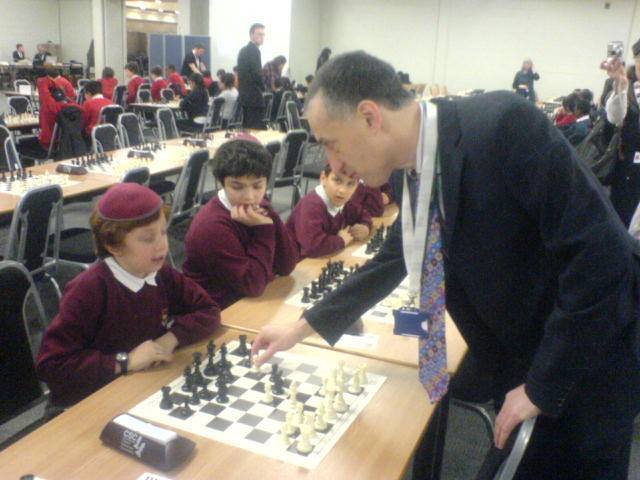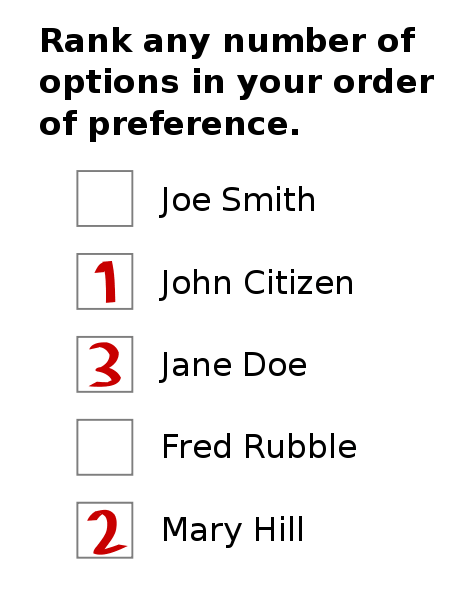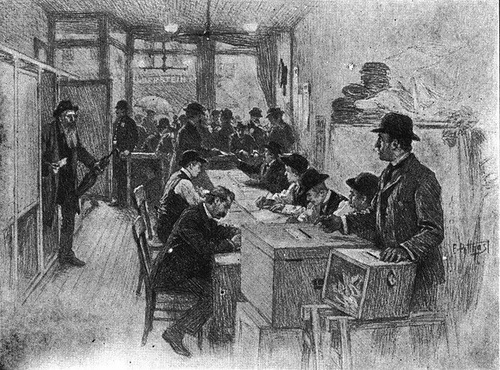
Election Method Theory Provides Proper Strategy and Purpose for Democracy Chronicles Poll including the elusive ICT rank-count rule.
Strategies for voting. Purposes of poll. Information from poll. ICT rank-count rule. Democracy Chronicles!
This article elaborates on or explains things said in the ballot-introduction and voting-instruction for the rank-balloting poll. In this article, and any discussion of voting systems, the word “method” means “voting-system”, consisting of a balloting procedure and a count rule for finding the winner based on the ballots. For voting instructions for Approval, and strategy suggestions for Approval (if you want to consider strategy), use this link to my Approval article or go to the introduction to our Approval poll.
The Approval poll (still ongoing) has two purposes:
1. To demonstrate a voting system that, for the first time, would fully allow expression, measurement, and realization of what people really want. Don’t underestimate the importance, or the societal benefit of that. …And it’s a method that is uniquely feasibly proposable and enactable, because it’s the most minimal change from our usual official “Vote-for-1” method, the one that we use every two years, to elect compromises that we don’t like. And it’s method that merely amounts to a repeal of the unjustifiable, ridiculous and democracy-ruining rule that characterizes Vote-for-1. (For details on that, see my initial Approval article, entitled “Some Problems With Our Current Voting System: Plurality Voting.”
In addition to introducing Approval, the poll also serves to show what it’s actually like to vote in an Approval election. For showing that, there is nothing like actually participating in an election (even a mock election such as ours).
2. To show what people really like. As I said in the Approval article, Approval shows that well, because you can give top rating (“Approved” rating) to every candidate you like including all of your favorites, in addition to any compromise that you might want to approve.
And so what has our Approval poll shown so far? The Republicans are regarded as the threat that makes it necessary to support the Democrats, in order that someone will win instead of the Republican. But what did we voters say about that in our poll? We said that we didn’t like the Republicans very much. The Republican was at the bottom, tied for least-approved.
And that isn’t at all unusual, either. It’s a result that is consistently found in Internet polls. Is it explainable by saying that Republicans don’t have computers? I doubt it. Maybe it’s explainable by saying that there aren’t many Republican-preferrers. Are the Republicans really just the Boogie-Man whose job is to scare you into voting Democrat?
That result has great strategic importance, for those whose first goal is that someone better than the Republican win: With the Republican polling so low, and with the Greens right up near top, contending for top, the Greens can easily outpoll the Republican (if people actually support whom they really like). It means that, if our poll-participants are a representative sample of the larger set of voters, a person who prefers the Greens’ policy proposals to those of the Democrats needn’t support the Democrat in order to keep the Republican from winning–because the Green can outpoll the Republican. There is no need to support an unliked compromise, if someone better can poll higher than the Republican. The “lesser-of-2-evils” problem is gone.
The Democrat/Republican good-cop/bad-cop scam is history. And, as I said, results like this are typical, consistently found in Internet polls. For example, in Internet polls that included Republicans, Democrats, and Ralph Nader, Nader consistently won. That has got to tell you something. Maybe the public don’t really prefer the Democrats or the Republicans, as the media would have you believe. Maybe the Democrats and Republicans aren’t really “the two choices”.
Polls on issues have also consistently shown that the public are considerably more progressive than the candidates and policies of the Republicans and Democrats. When a certain Democrat president said that single-payer national health insurance for all was “not viable”, Noam Chomsky said something to this effect: “No, it isn’t viable, because only the people want it”.
It’s the same, right across the board: More progressive tax rates (less tax on people with less income). Humane and equitable policies of all kinds, for which the Democrats and Republicans never have and never will deliver more than the same old rhetoric.. The tv has made each individual feel that s/he is the only person who would prefer those things. All the evidence says otherwise. If our poll voting-sample is representative of the larger voting public, and if people knew that, and voted accordingly, then maybe the next president would be a Green. No, I’m not joking or exaggerating. If that sounds optimistic, I’ll point out that reality is optimistic. Pessimism and resignation are taught by your television. Disregard it.
In Approval, your best strategy is to approve optimistically, and the results will reflect that. So, look at some party platforms, online, and determine which one sounds more like what you would like–the way you’d like things to be. You aren’t required to do that before you vote in the Approval poll or the rank-balloting poll, but it wouldn’t hurt–to make your ballot as effective and expressive as possible. All that discussion above was to tell what the Approval poll showed (though lots of other polls and conversations show it all the time). That’s the second purpose of the Approval poll.
What about the purpose of the rank-balloting poll? It’s purpose is the same as that second purpose of the Approval poll. But it allows you to express more detailed preferences, by which you, collectively, via the rank-balloting and count, can point directly to the voter-median candidate, to show you and all of us the best candidate, party, or candidate-category that we can help to win. Ambitious claim? Yes, but it’s a fancy and deluxe voting system.
(At this point, I should add that, as our Approval poll shows, Approval’s results, too, give enough information to inform and guide our voting, in our actual official elections. The truth is that Approval can’t be much improved upon, even by the most deluxe rank-balloting methods. Additionally, the rank-balloting methods have the problem that there are infinitely-many ways to count ranked ballots.
A person can always ask, “Why should we use your rank-count, instead of one of the infinitely-many other ones?”. There will never be agreement on which rank-count to use. The methods more elaborate than Approval will be debated and argued from now on, and there will never be agreement on which one to propose or enact.
Approval, by contrast, is the unique simplest, most minimal and modest change in our current Vote-for-1 system, the method that amounts only to a repeal of the rule that makes Vote-for-1 so anti-democratic. For details I refer you to my Approval article, entitled “Some Problems With Our Current Voting System: Plurality Voting“.So I recommend Approval as the method to propose. But nevertheless, I wanted to show another voting system, the rank-method used in this poll, partly to show that I’m not ignoring the fancier and more elaborate methods, and partly to show another, fancier, way to find the most winnable candidate, for informing and guiding our voting in our official public elections.) Now, to name, define and describe the count-rule by which we’ll count the ballots in this rank-balloting poll:
The rank-count method is called “ICT”. That stands for “Improved-Condorcet-Top”. Here, I’ll define it, and tell how it works, and why it has the strategy-guarantees that I specified in the ballot-introduction and voting-instruction for this rank-balloting poll. To define ICT, I should first define Condorcet’s method, as that term is usually interpreted. Then I’ll discuss a few problems of Condorcet. The fixing of those problems leads to ICT, and its strategy guarantees.
Condorcet’s method says:
X beats Y if the number of voters preferring X to Y is greater than the number of voters preferring Y to X. If there is a candidate who isn’t beaten, then s/he wins (of course if there are several who are unbeaten, then they all win, in a tie.) But it’s possible that no one wins. For that contingency, there are various “Condorcet completions” proposed. Not very modestly, I’ll say that I introduced and successfully advocated the most popular class of Condorcet completions–The “Winning-Votes Condorcet methods”.
There’s no need to lengthen an already-long article by defining the various Condorcet completion methods. Suffice it to say that they all share two avoidable problems:
1. Favorite-burial:
The main problem that Approval avoids. With Condorcet, it can happen that, if Compromise is the only candidate who can beat Worse, then the only way you can help Compromise win instead of Worse, is to rank Compromise _alone_ in 1st place. If someone other than Compromise is your favorite,then that’s too bad, because you have to rank your favorite below Compromise. Does that sound familiar? It’s what we don’t like about our “Vote-for-1” system, the one that we use every two years to elect a compromise that we don’t really like.
Voting a compromise over your favorite should never be the only way to defeat someone worse. For instance, in Approval, as long as you approve Compromise, and not Worse, you’re fully helping Compromise against Worse, even if you also approve all of the candidates you like better than Compromise. Even if you approve all of your favorites, in addition to Compromise.
But, with Condorcet, you aren’t really fully helping Compromise against Worse unless you rank Compromise “alone” in 1st place. In that very important way, Condorcet isn’t as good as Approval. Condorcet fails where Approval doesn’t fail. ICT shares Approval’s guarantee in that regard. You can rank all of your favorite candidates in 1st place, along with Compromise, and still be fully helping Compromise against Worse.
How does ICT achieve that?
2. Here is the definition of ICT. Note the difference in how ICT defines “beat”:
X isn’t beaten by Y if the number of people ranking Y over X is not greater than the number of people ranking X over Y, plus the number of people ranking both X and Y in 1st place. If there is one unbeaten candidate, then s/he wins. If there are no unbeaten candidates, then the candidate ranked in 1st place on the most ballots wins. If there are several unbeaten candidates, then the unbeaten candidate ranked in 1st place on the most ballots wins.
Note that, in ICT, ranking X and Y both in 1st place is just as good as ranking X over Y, for the purpose of keeping Y from beating X. That’s what gives ICT its Approval-like guarantee that no one ever has any strategic need to vote anyone over their favorite. Just as, in Approval you never have any reason to not give top rating (an “Approved” rating) to all of your favorites, so, in ICT you never have any reason to not give top rating (1st place ranking) to all of your favorites.
Chicken-Dilemma, Co-operation/defection Problem, “You-Help-You-Lose”:
In the voting-instructions, I said that defection backfires in ICT. That defection doesn’t work in ICT. Here’s the scenario. Say the method is Condorcet winning-votes, and that there are 3 candidates: A, B, and C. The A voters and the B voters all greatly prefer A and B to C. The A voters and the B voters despise C. Now, say the A voters, being conscientious, co-operative and honest, sincerely rank B over C, to help B defeat C.
That gives B a majority pairwise defeat against C, and ensures that C won’t win. But suppose that the B voters prefer to benefit from that help from the A voters, without likewise helping the A voters. So they don’t rank A. They let C beat A. The result is that B wins, because the A voters helped B, but the B voters didn’t help A. That will make the A voters hesitate to help B. “You help, you lose”.
What if you were an A voter? Would you help B by ranking him/her 2nd? Why doesn’t that defection work in ICT? Because the defection, by letting A be beaten by C, causes there to be no unbeaten candidates. When there are no unbeaten candidates, ICT only looks at 1st choices. That means that, when the B voters defect against you and your candidate, A, you withdraw your help from B. The defection will backfire.
You don’t share help, you don’t get help. When the B voters refuse to help your candidate, they find that your help for their candidate is gone. That means that you can freely and safely rank sincerely, without fear of defection by the B voters. That gets rid of the chicken dilemma, the co-operation/defection problem. In summary, ICT gets rid of the two strategy problems that could otherwise distort the results of a rank-balloting poll or election.
Now, just one more thing: Gibbard & Satterthwaite proved that all non-random voting systems have strategy. No method is entirely free of strategy in an actual official election that elects office-holders. With pretty much any rank method (at least I don’t know of any exceptions), here is one situation that calls for strategy: Suppose that there are one or more unacceptable candidates who could win.
For someone who wants a complete definition, let me put it this way:
Say that there are two sets of candidates, whom we’ll call the “acceptables” and the “unacceptables”. Say that the merit differences among the accepetables, and the merit differences among the unacceptables are negligible in comparison to the much greater merit difference “between” the acceptables and the unacceptables.
In other words, keeping the unacceptables from winning is a lot more important than which acceptable or unacceptable wins. Your best strategy is to rank all of the acceptables in 1st place, and to not rank any of the unacceptables. That’s the case in ICT. Actually, in Condorcet, you won’t really know what to do. That’s because, as described above, Condorcet (but not ICT) can make you regret ranking a favorite in 1st place with a compromise, because doing so can defeat your compromise.The strategy situation is worse in Condorcet, because sometimes that’s the best strategy and sometimes it isn’t, and you might not know whether it is or not. So, even with ICT, there is a situation that calls for strategy–in an official public political election that will elect an officeholder.
But our poll is not such an election. The above-described strategy-need doesn’t exist in our poll. This is an informational poll. The information that its result can give is for you. It is in your best interest to rank sincerely, so that ICT can show you, and all of us, which is the best candidate, party, or candidate-classification that we can help to win. Then, knowing that, we could combine our votes, in the official public Vote-for-1 election (like the one coming up in November) on an that candidate, or on an agreed-upon candidate of that party or candidate-category.





Adrian Tawfik says
This looks great!